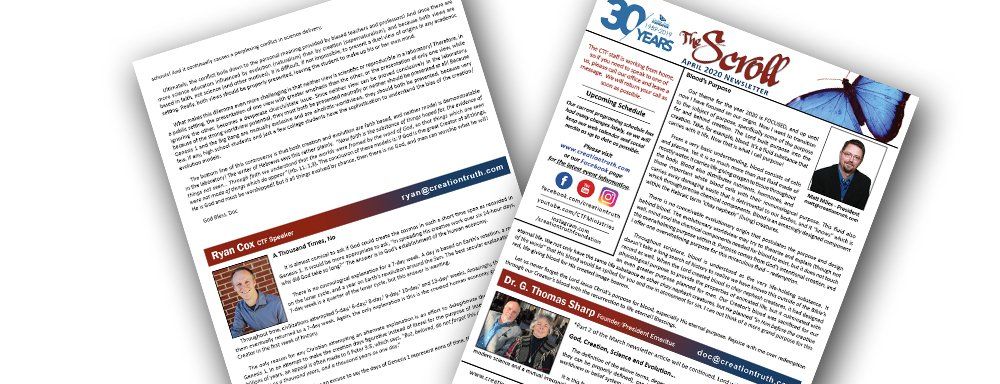Radiometric Dating: How Men Aged the Earth
The War
“My primary aim is to demonstrate the age of the earth , or rather the vast age of rocks. This is very much a personal view and not all will agree with me. For example Dr Eugenie Scott of the National Council for Science Education in San Diego strongly disagrees with me when I told her that the primary aim must be to convince people of the age of the earth and then let evolution sort itself out … I am thinking strategically rather than scientifically. Once someone has accepted a vast age of the earth they have moved from Ussher to William Smith (who produced the first geological map in 1815), for the simple reason that if the earth is more than 50,000 years old Biblical literalism is a dead duck … It is far too much to expect someone to jump from Ussher to Darwin in one go. If I can persuade someone that the earth is at least a million years old I consider the WAR to be won . The rest is mopping up!” (emphasis added)
Michael Roberts, Vicar in the Blackburn Diocese (Anglican, UK), “Creationism on the Rocks: A Geological Look at Creationism”, 2003 web article, accessed 2/23/18, https://michaelroberts4004.wordpress.com/2014/11/23/british-creationism-as-a-problem-in-2002/
“The important point is that since the origin of life belongs in the category of at-least-once-phenomena, time is on its side . However improbable we regard this event… given enough time it will almost certainly happen at least once… Given so much time, the ‘impossible’ becomes possible, the possible probable, and the probable virtually certain. One has to wait; time itself performs the miracles .” (emphasis added)
Dr. George Wald, Nobel laureate and Harvard professor, p. 12 of chapter “The Origin of Life” in The Physics and Chemistry of Life , by the editors of Scientific American. Simon and Schuster, 1955.
“Darwinian Naturalism needs TIME and lots of it! This is the bottom line in the WAR between good and evil!
Dr. G. Thomas Sharp, founder of Creation Truth Foundation, IBWS cadre notes, “Philosophical Naturalism and the Age of the Universe”, slides 40-41
So, I believe that the entire struggle between Supernaturalism and Naturalism boils down to what we believe about Time, Age of the Universe, Earth and Man . All other of the mutually exclusive ramifications of the debate are explained here.” (emphasis added)
How it Happened
“Increasing constraints were placed upon the interpretation of nature in view of the teachings of the Bible . This required that the Earth be conceived of as a static, unchanging body, with a history that began in the not too distant past, perhaps as little as 6,000 years earlier… This biblical history of the Earth left little room for interpreting the Earth as a dynamic, changing system. Past catastrophes, particularly those that may have been responsible for altering the Earth’s surface such as the great flood of Noah, were considered an artifact of the earliest formative history of the Earth… With the exception of a few prescient individuals… no one stepped forward to champion an enlightened view of the natural history of the Earth until the mid-17th century .” (emphasis added)
Encyclopedia Britannica , “Geochronology”, accessed 2/22/18, https://www.britannica.com/science/geochronology#ref586344
The History
1669 – Nicolas Steno (1638-1686, Danish anatomist) establishes the principles of stratigraphy (the study of the layering and positions of rock strata).
1722-1732 – Benoît de Mailet (1656-1738, French diplomat) estimates Earth to be 2.4 billion years old. He believed the planet was once completely covered by water, which was receding into a vortex at a rate of 3 inches per century.
1748 – David Hume (1711-1776, Scottish philosopher) publishes An Enquiry Concerning Human Understanding , in which he states, “all inferences from experience suppose.. that the future will resemble the past.” This gives rise to the philosophy of uniformitarianism – interpreting past events by current processes.
1756 – Johann Lehmann (1719-1767, German mineralogist) labels three distinct rock layers while studying mining practices in Prussia. They are 1) Primary layer of crystalline rocks, 2) Secondary layer of fossiliferous rocks, and 3) Final layer of recent sediments.
1778 – Comte de Buffon (1707-1788, French mathematician) estimates Earth to be 75,000 years old in his book The Eras of the Nature.
1788 – James Hutton (1726-1797, Scottish farmer and chemical manufacturer) popularizes the philosophy of uniformitarianism in his work Theory of the Earth , in which he states that “from what has actually been, we have data for concluding with regard to that which is to happen thereafter.”
1812 – Georges Cuvier (1769-1832, French zoologist) proposes the concept of Progressive Creationism in Essay on the Theory of Earth. He maintains that geology shows at least four regional or nearly global floods over untold ages, the most recent being 5,000 years ago. After each catastrophe, God created new forms of life. This is why we see different animal fossils throughout rock layers.
1814 – Thomas Chalmers (1780-1847, Scottish minister) proposes the concept of gap creationism, known today as Gap Theory. It holds that Genesis 1:1 records the first creation and Genesis 1:2-31 records a second or re-creation. In between the two is a period of however many years anyone wants to insert to make the universe as old as one wants.
1815 – William “Strata” Smith (1769-1839, English surveyor) publishes his first geologic map. He had traveled throughout England as a surveyor, examining canals, road and railway cuttings, mines, and quarries. He noted similar looking strata with corresponding fossils. Smith becomes known as the “Father of English Geology”.
1830-1833
– Charles Lyell (1797-1875, Scottish lawyer) publishes his 3-volume set entitled Principles of Geology: being an attempt to explain the former changes of the Earth’s surface, by reference to causes now in operation. In it, he restates Hume and Hutton’s philosophies of uniformitarianism.
* June 14, 1830 – Charles Lyell composes a letter to George Poulett Scrope (English geologist, 1797-1876) discussing his strategy of getting churches to accept old ages of the Earth through his argumentative tactics as a lawyer for the purpose of rejecting the Bible’s history. He states, “I am sure you may get into Q.R. [ Quarterly Review
] what will free the science from Moses
, for if treated seriously, the [church] party are quire prepared for it… They see at last the mischief and scandal brought on them by Mosaic systems
…” (Bailey, E. British men of science: Charles Lyell. Nelson and Sons, Ltd. London. 1962. pp. 77-8, emphasis added).
* May 4, 1832 – Charles Lyell lectures at King’s College in London, saying, “…the physical part of Geological inquiry ought to be conducted as if the Scriptures were not in existence
” (Rudwick, Martin. “Charles Lyell Speaks in the Lecture Theatre”. The British Journal for the History of Science
9
(2):147-155, 1976, emphasis added).
* 1975 – Stephen Jay Gould (1941-2002, Harvard evolutionary biologist) writes, “Charles Lyell was a lawyer by profession… [and he] relied upon two bits of cunning to establish his uniformitarian views as the only true geology. First, he set up a straw man to demolish… In fact, the catastrophists were much more empirically minded than Lyell. The geologic record does seem to require catastrophes
: rocks are fractured and contorted; whole faunas are wiped out. To circumvent this literal appearance
, Lyell imposed his imagination upon the evidence
” (Gould, S.J., Catastrophes and steady state earth, Natural History
, 84
(2):15–18, 1975, emphasis added).
1841 – John Phillips (1800-1874, English geologist), estimates Earth to be 96 million years old. He had traveled all over England with his uncle, William “Strata” Smith, and later became a geology professor at King’s College. He publishes in 1841 the first global geologic time scale, based entirely from his and his uncle’s surveys of England. The map uses fossils in layers as identifiers of strata, popularizing the terms Paleozoic and Mesozoic.
1856 – Hermann von Helmholtz (1821-1894, German physicist) uses observations of “heat death” in the universe to determine the maximum amount of time for the universe to reach thermodynamic equilibrium (all the energy to be used up). He then calculates that the Earth can be no more than 22 million years old.
1859
– Charles Darwin (1809-1882, English naturalist) publishes On the Origin of Species by Means of Natural Selection, or the Preservation of Favoured Races in the Struggle for Life. He postulates that Earth must be 300 million years old in order to have enough time for his scheme of evolution.
* January 31, 1869 – Darwin writes to James Croll (1821-1890, Scottish scientist researching the Ice Age), “Not withstanding your excellent remarks on the work which can be effected within a million years, I am greatly troubled at the short duration of the world
according to sir William Thomson for I require for my theoretical views a very long period before the Cambrian formation
” (accessed 2/23/18, https://www.darwinproject.ac.uk/letter/DCP-LETT-6585.xml).
1892 – Simon Newcomb (1835-1909, Canadian astronomer) calculates Earth to be 18 million years old based on the gravitational contraction of the Sun.
1893 – Clarence King (1842-1901, American geologist), while serving as the first director of the US Geological Survey, estimates Earth to be 24 million years old.
1893 – Charles Walcott (1850-1927, American paleontologist), while serving as Secretary of the Smithsonian Institution, estimates Earth to be 55 million years old, based on his study of sedimentation.
1895 – John Perry (1850-1920, Irish engineer) estimates Earth to be 2 to 3 billion years old.
1896 – Antoine Henri Becquerel (1852-1908, French physicist) discovers uranium emits invisible rays, making him the first to discover radioactivity.
1897 – William Thomson, 1st Baron Kelvin (1824-1907, Scots-Irish physicist & engineer) estimates Earth to be 20 to 40 million years old. He then claims that this time frame makes Darwinian evolution impossible.
1898 – Pierre (1859-1906) and Marie Curie (1867-1934, French physicists & chemists) discover the radioactivity of thorium and coin the term “radioactivity”. They go on to receive the 1903 Nobel Prize in Physics.
1898 – George Darwin (1845-1912, English astronomer & Charles Darwin’s son) calculates Earth to be 56 million years old based on his understanding of the Earth/Moon system. This severely undercuts the amount of time his father needed for his scheme of evolution.
1899 – John Joly (1857-1933, Irish physicist) calculates Earth to be 89 million years old based on oceanic sodium accumulation.
1907 – Bertram Borden Boltwood (1870-1927, American radiochemist) takes measurements that indicate that lead is the final product of uranium decay. He attempts to calculate the age of Earth by postulating a decay rate. He obtained results of 400 million to 2.2 billion years old.
1907 – Ernst Rutherford, 1st Baron Rutherford of Nelson (1871-1937, British physicist) discovers the half-life principle of radioactive elements. He becomes known as the “Father of Physics”.
1909 – John Joly revives his estimate of Earth’s age to 150 million years old.
1913 – John Joly revises his estimate of Earth’s age to at least 400 million years old based on radium decay rates.
1917 – Oxford University publishes a revised version of the Scofield Reference Bible, in which the reference notes in Genesis 1 interpret the passage through the lenses of the Gap Theory. This gains the Gap Theory considerable notoriety to the point that in 1954, Baptist theologian Bernard Ramm (1916-1992) writes, “The gap theory has become the standard interpretation throughout hyper-orthodoxy, appearing in an endless stream of books, booklets, Bible studies, and periodical articles. In fact, it has become so sacrosanct with some that to question it is equivalent to tampering with Sacred Scripture or to manifest modernistic leanings” (Ramm, B. The Christian View of Science and Scripture. Wm. B. Eerdmans Publishing Co. 1954, p. 135).
1921 – Henry Russell (1877-1957, American astronomer) calculates a maximum chemical age of 8 billion years for Earth’s crust, based on estimates of its total uranium and lead content. He co-developed the Hertzsprung-Russell diagram in 1910.
1927 – Arthur Holmes (180-1965, British geologist) presents an age of Earth ranging from 1.6 to 3.0 billion years in his The Age of the Earth: An Introduction to Geological Ideas. His work is mostly ignored as he bases his conclusions on radiometric dating. By this time, the study of radioactivity and accurately measuring radioactive decay had been abandoned as too complicated and unreliable.
1931
– The National Research Council of the US National Academy of Sciences declares radiometric dating to be the most reliable means of dating rocks. How was this conclusion reached?
Arthur Holmes was appointed a committee member as he was one of the only people in the entire country trained in radiometric dating. He wrote most of the final report, which just happened to claim that radioactive dating was the only reliable means of dating geologic time scales (exactly what his rejected book claimed). There were accusations of bias, but were beaten back by the Academy, making radiometric dating the primary means of dating rock samples.
1956
– Clair Patterson (1922-1995, American geochemist) calculates Earth’s age to be 4.55 ± 0.07 billion years old. His calculations are based on lead-lead isotope dating of meteorites. Why?
Wikipedia notes: “ Most geological samples from Earth are unable to give a direct date of the formation of Earth
from the solar nebula because Earth has undergone differentiation into the core, mantle, and crust, and this has then undergone a long history of mixing and unmixing of these sample reservoirs by plate tectonics, weathering and hydrothermal circulation. All of these processes may adversely affect isotopic dating mechanisms
because
the sample cannot always be assumed to have remained as a closed system
… which will skew the resulting isotopic date
… Some meteorites are furthermore considered to represent the primitive material from which the accreting solar disk was formed. Some have behaved as closed systems (for some isotopic systems) soon after the solar disk and the planets formed. To date, these assumptions are supported by much scientific observation and repeated isotopic dates, and it is certainly a more robust hypothesis than that which assumes a terrestrial rock has retained its original composition” (accessed 2/21/18, https://en.wikipedia.org/wiki/Age_of_the_Earth, emphasis added).
* Therefore, meteorites must be used as all rock samples yield unreliable dates, which has been noted since the 1920s!
* How then are radiometric dates of meteorites independently confirmed?
“The Earth has aged dramatically during the three centuries of the scientific era. The estimated age doubled on the average every 16 years since the middle of the 17th century…” (emphasis added)
Fred L. Whipple, American astronomer, “The Earth as Part of the Universe”, Annual Review of Earth and Planetary Sciences , 1978, 6:1-8. Annual Reviews, Inc. pp. 1-2.
Rocks Date the Fossils & Fossils Date the Rocks
“ The rocks do date the fossils , but the fossils date the rocks more accurately . Stratigraphy cannot avoid this kind of reasoning if it insists on using only temporal concepts, because circularity is inherent in the derivation of time scales… Radiometric dating would not have been feasible if the geologic column had not been erected first .” (emphasis added)
J.E. O’Rourke, “Pragmatism versus Materialism in Stratigraphy”, American Journal of Science , Vol. 276, January 1976, pp. 53-4.
The Dating of Rock Layers Came BEFORE Radiometric Dating
“ By the 1850s , with the development of the geologic time scale nearly complete , investigators were beginning to recognize that a number of major paleontologically defined boundaries were common and recurrent regardless of where a succession was studied. By this time rock successions were being defined according to fauna they contained, and the relative time scale, which was being erected, was based on the principle of faunal succession ” (emphasis added)
Encyclopedia Britannica , “Geochronology”, accessed 2/22/18, https://www.britannica.com/science/geochronology#ref586344
“…I wonder how many of us realize that the time scale was frozen in essentially its present form by 1840 . How much world geology was known in 1840? A bit of Western Europe, none too well, and a lesser fringe of North America, all of Asia, Africa, South America, and most of America were virtually unknown. How dared the pioneers [of this theory] assume that their scale would fit the rocks in these vast areas, by far most of the world? Only in dogmatic assumption a mere extension of the kind of reasoning developed by Werner from the facts in his little district of Saxony. And in many parts of the world , notably India and South America, it does not fit . But even there it is applied! The followers of the founding fathers went forth across the Earth and in Procrustean fashion made it fit the sections they found , even in places where the actual evidence literally proclaimed denial . So flexible and accommodating are the ‘facts’ of geology.” (emphasis added)
Edward M. Spieker, American geologist, “Mountain-Building and Nature of Geologic Time-Scale”, bulletin of the American Association of Petroleum Geologists, Vol. 40 (August 1956), p. 1803.
Conclusion
“Radiometric dates are only accepted if they agree with what geologists already believe the age should be.” (emphasis added)
Dr. Tasman Walker, Creation Ministries International, “The way it really is: little-known facts about radiometric dating. Long-age geologists will not accept a radiometric date unless it matches their pre-existing expectations.” Creation 24 (4): 20-23 – September 2002. https://creation.com/the-way-it-really-is-little-known-facts-about-radiometric-dating
SOURCES for The History:
Chambers, John and Jacqueline Mitton. From Dust to Life: The Origin and Evolution of Our Solar System. Princeton University Press. May 2017, pp. 57-64.
Encyclopedia Britannica. “Geochronology”. accessed 2/22/18. https://www.britannica.com/science/geochronology#ref586344



